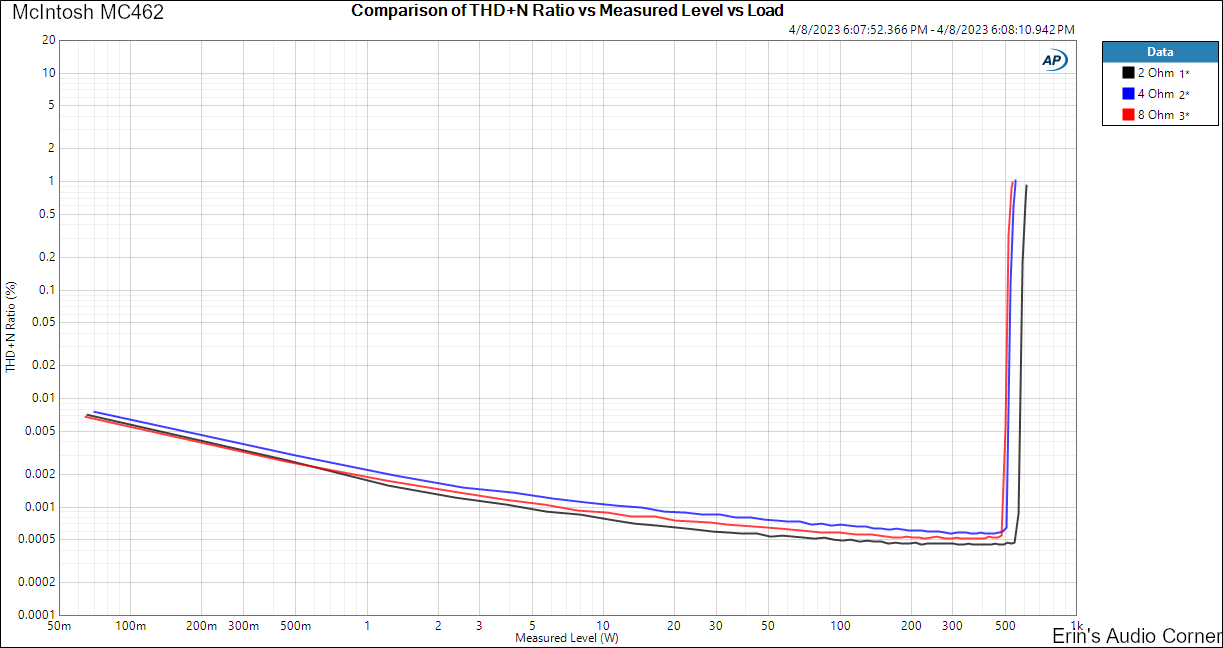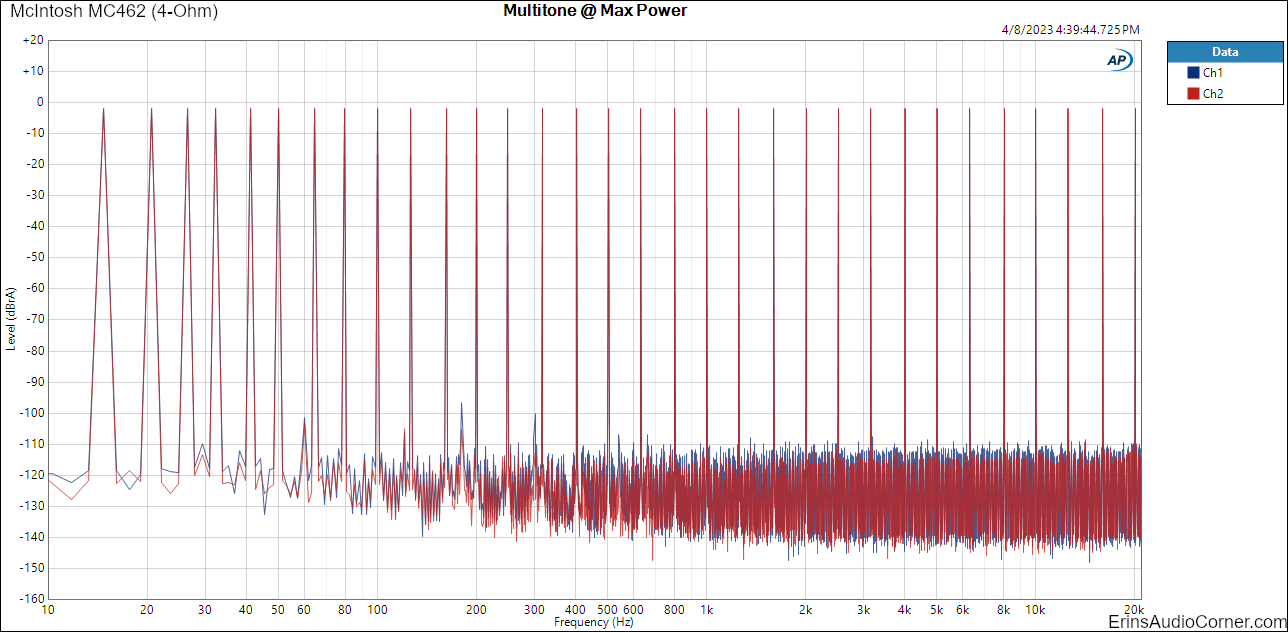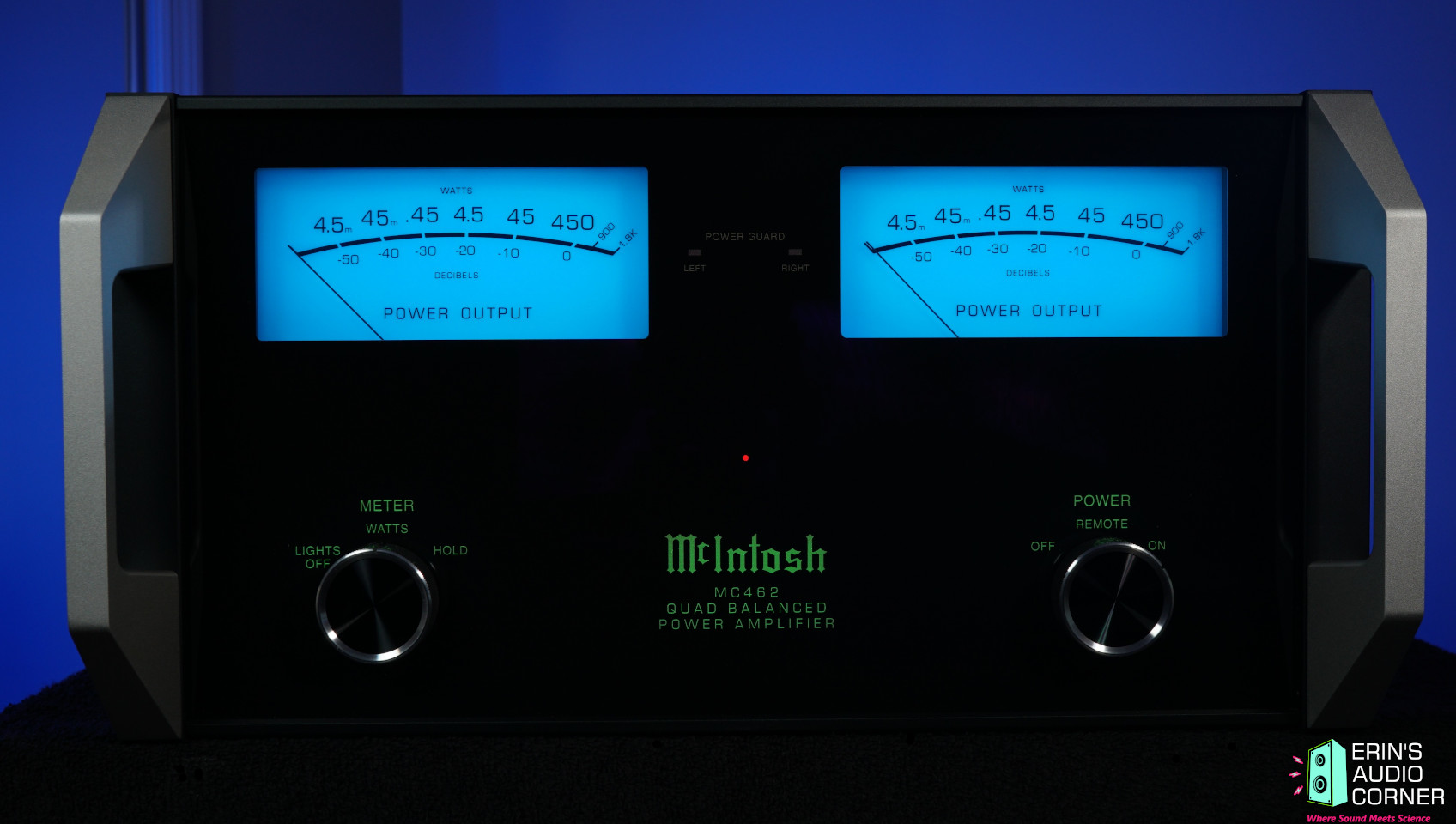Foreword / YouTube Video Review
This item was loaned to me by McIntosh. I was not paid nor given anything in return for this review.
All my reviews are done on my own time with great care to give you all the best set of data and information I can provide in order to help you make a well-informed purchase decision. I offer this for free to all who are interested. In return, if you want to support this site please see the bottom of this review for ways you can help. It is greatly appreciated.
The review on this website is a brief overview and summary of the objective performance of this processor. It is not intended to be a deep dive. Moreso, this is information for those who prefer “just the facts” and prefer to have the data without the filler. The video below has more discussion with respect to the technical merits and subjective notes.
Information and Photos
Some specs from the manufacturer are below and full specs can be found here.
- Power Output: 450 Watts into 2, 4 or 8 Ohm speakers
- Total Harmonic Distortion: 0.005% maximum from 20Hz to 20kHz
- Signal to Noise Ratio: 122dB Balanced 120dB / Unbalanced
- Dynamic Headroom: 3.0dB
- Damping Factor: Greater than 40 Wideband
- Frequency Response: +0, -0.25dB from 20Hz to 20kHz / +0, -3.0dB from 10Hz to 100kHz
- Inputs & Outputs: 2 Balanced inputs / 2 Unbalanced inputs / 2 Balanced outputs / 2 Unbalanced outputs
As of this writeup, the MSRP is approximately $10,000 USD.
Test Setup Information:
Testing was conducted using the Audio Precision APx555B.
- Warmup: Unit was provided pink noise with an output of 1 watt into a 4-ohm load for 10 minutes.
- Test Bandwidth: 22.4kHz (48 kHz Sample Rate) (unless otherwise stated)
- Input to DUT: Balanced XLR.
- Output from DUT: Balanced XLR.
- Volume/Gain: N/A.
- DSP Settings: N/A.
- “Ch1” = Left Output. “Ch2” = Right Output.
- Tests were run at 2, 4 and 8-ohm loads. Both channels loaded. However, due to server space costs, results published here are based upon the 4-ohm testing (unless otherwise noted).
- Future Note: I do plan to conduct tests with a reactive (speaker simulator) load but parts are currently out of stock so this test does not currently include said reactive load testing. If that changes I will update this review.
- All testing was run at two power levels:
-
- 1 Watt RMS @ n-Ohm. This provides a clear apples-to-apples method of comparison against all future testing. 1 watt is sufficient to power a nominally rated sensitivity speaker pair to approximately 80-85dB at most listening distances in typical rooms.
-
- “Max Power” @ n-Ohm. This is referenced to 0.10% THD+N, unless otherwise stated. Why this distortion+noise level and not something else? Because manufacturers rate their “max” at different THD+N values. In order to establish a reasonable baseline I decided that 0.10% THD+N was a good middle ground to target this “max power” testing.
-
The full Audio Precision test report(s) is available to my Patrons via my Patreon Page (link). Why behind a paywall? Simple: this stuff costs me a lot of money and I’m sharing the meat of the results for free here but for those who want the full report you’ll have to be a Patron.
Frequency Response
Response shows some load dependency but outside the audible hearing range except for a minor (0.130dB) dip at 2-ohms at 20kHz. The LF shows a deviation from flat, about 0.30dB down at 10Hz. This aligns with McIntosh’s specification.
THD+N
The below graphic shows the THD+N as output level increases from left to right on the X-axis. I am showing only one channel here - which is the worst channel - for each load.
We see the typical decrease in THD+N as the amplifier moves out of its noisy region and into the distortion-dominated region at both the left and rightmost extremes, respectively. Ultimately what I see is an amplifier with low noise and extreme 2-channel power, hitting well over 500 watts into each of the 2/4/8-ohm loads while still being below 0.001% THD+N. That’s remarkable. More on power in the next section.

THD+N at Different Frequencies
The THD+N graphic above is referenced only to 1kHz for each load. The graphic below shows the THD+N for a 4-ohm load at varying frequencies.
Max Continuous & Peak Power
The table below lists measured output ratings at varying loads and test conditions. Maximum continuous power is provided at both 0.01% & 1.0% THD+N. Why both? Because we often see manufacturer’s use different ratings so I wanted to cover my bases. Peak Power, which is also known as “headroom”, is referenced to 1.0% THD+N (per CEA-2006/490A). Here is a detailed description of this test.
| 2-Ohm | 4-Ohm | 8-Ohm | ||||
|---|---|---|---|---|---|---|
| Left | Right | Left | Right | Left | Right | |
| Max Continuous Output at 0.01% THD+N (watts) | 564.2 | 573.4 | 502.7 | 501.7 | 494.7 | 493.9 |
| Max Continuous Output at 1.00% THD+N (watts) | 605.2 | 640.9 | 545.8 | 547.5 | 537.9 | 540.9 |
| Peak Power at 1.00 THD+N (watts) (CEA-2006/490A) | 828.4 | 847.7 | 823.4 | 821.8 | 793.6 | 792.4 |
Dynamic Range - AES17 (Conducted at Max Power)
| Channel | Dynamic Range (dB) |
|---|---|
| Channel 1: | 122.049 |
| Channel 2: | 122.883 |
Crosstalk
Linearity
Phase
Input Gain
Multitone Distortion

Parting / Random Thoughts
A couple notes:
- This amp is a powerhouse. I won’t get into my subjective thoughts here but I will simply say that I ran a few different speakers (Wharfedale Linton, Monitor Audio Silver 7g and SVS Ultra Prime) just to see how well this amp reacted to the different loads and they rocked the house. At levels that the speakers simply weren’t meant to play. Ultimately, what this means to you is that you not only have plenty of power available for low sensitivity speakers but you also have a lot of dynamic headroom for transient peaks (up to ~850wpc). I can’t imagine the need for more power - at least not in typical domestic living spaces.
- I had the MC462 powered for hours at a time and while it did get quite warm to the touch it never suffered any faults such as thermal shutdown.
- The Power Guard feature works as advertised and you can see this clearly in the Wattage vs THD+N graphs where additional input past ~4.4 Vrms resulted in no additional output (but, most importantly, no distorted output). From the data, it appears Power Guard limits the amplifier from exceeding levels where THD+N is greater than 1%. The Input Gain graphic also provides additional evidence for this where at approximately 4.4 Vrms the output power is capped at about 500w (at 4-ohms).
- McIntosh rates this amplifier at 450wpc at 2/4/8-ohm loads with their specification page citing “0.005%” THD. My tests show this to be a tad conservative where this distortion level was closer to 500wpc at this value for all loads. Again, that’s 500 watts per channel at a distortion value of less than 0.005%.
- So, here is the part where I take a bit of a detour. McIntosh’s “Dynamic Headroom” is rated at 3.0dB. If one were using my data then we see at 4-ohms the continuous power vs max peak (headroom/dynamic range) at 1% THD+N 546 watts and 823 watts, respectively (left channel). For a true 3dB of ‘headroom’ - which is doubling of power - the max peak power would have to be closer to 1092 (546w*2) or the max continuous would need to be 411.5 watts (823w/2). But the truth here is I do not know how McIntosh is rating their Dynamic Headroom spec. I do not know where their reference is; if it’s 1.0% THD+N or 0.01% THD+N or 0.005% THD (no “+N”). Therefore, depending on what they are referencing this 3dB Dynamic Range value may very well be legitimate. And given the overall performance of this amplifier, I have no reason to believe McIntosh is fudging specs. My guess is their reference is simply different from mine.
The MC462 delivers power like nothing I’ve ever used before. Go back and look at the table I provided. At least 500wpc into any load with more to spare in dynamic power. You won’t be wanting for power unless you have an extremely attypical speaker setup. Nevermind the legitimately great performance, I like the meters. I’m a sucker for meters. There, I said it. I’ve been eyeing this amplifier for a few years now and was always a bit curious how it would really fare in a battery of tests. Well, now I know… and I want one more than before.
Oh, and if you are considering buying this amplifier make sure you either a) have a healthy deadlift capability or b) have a very strong friend. Preferably both, actually. At 115lbs, this amplifier is not easy to move around. And it’s even hard to maneuver when taking it out of the packaging.
Support / Contribute
If you find this review helpful and want to help support the cause that would be AWESOME! There are a few ways you can do so below. Your support helps me pay for new items to test, hardware, miscellaneous items needed for testing, new speakers to review and costs of the site’s server space and bandwidth. Any help is very much appreciated.
Join my Patreon: Become a Patron!
Shopping
If you want to help but can’t chip in directly and you are shopping at any of the following stores then please consider using my generic affiliate links below to make the purchase through.
Purchases through these links can earn me a small commission - at no additional cost to you - and help me continue to provide the community with free content and reviews. Doesn’t matter if it’s a TV from Crutchfield, budget speakers from Audio Advice or a pair of socks from Amazon, just use the link above before you make your purchase. Thank you!
